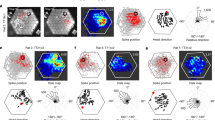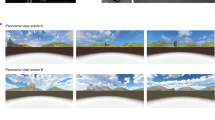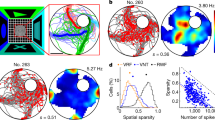Abstract
Animals can find a hidden goal in several ways. They might use a cognitive map that encodes information about the geometric relationship between the goal and two or more landmarks1. Alternatively, they might use a heading vector that specifies the direction and distance of the goal from a single landmark2. Rats with damage to the hippocampus have difficulty in finding a hidden goal3. Here we determine which of the above strategies is affected by such damage. Rats were required to swim in a water maze to a submerged platform, which was always at the same distance and direction from a landmark. The platform and landmark remained in the same place for the four trials of each session, but they were moved to a new position at the start of a session4. Rats with damage to the hippocampus found the platform more efficiently than did normal rats in the first trial of a session but, in contrast to normal rats, their performance did not improve during a session. Our results indicate that hippocampally damaged rats are able to navigate by means of heading vectors but not cognitive maps.
This is a preview of subscription content, access via your institution
Access options
Subscribe to this journal
Receive 51 print issues and online access
$199.00 per year
only $3.90 per issue
Buy this article
- Purchase on Springer Link
- Instant access to full article PDF
Prices may be subject to local taxes which are calculated during checkout





Similar content being viewed by others
References
O'Keefe, J. & Nadel, L. The Hippocampus as a Cognitive Map(Clarendon, Oxford, (1978)).
Collett, T. S., Cartwright, B. A. & Smith, B. A. Landmark learning and visuo-spatial memories in gerbils. J. Comp. Physiol. A 158, 835–851 (1986).
Morris, R. G. M., Garrud, P., Rawlins, J. N. P. & O'Keefe, J. Place navigation impaired in rats with hippocampal lesions. Nature 297, 681–683 (1982).
Roberts, A. D. L. & Pearce, J. M. Control of spatial behavior by an unstable landmark. J. Exp. Psychol. Anim. Behav. Proc. 24, 172–184 (1998).
Jarrard, L. E. On the use of ibotenic acid to lesion selectively different components of the hippocampal formation. J. Neurosci. Methods 29, 251–259 (1989).
Morris, R. G. M. Spatial localization does not require the presence of local cue. Learning Motiv. 12, 239–260 (1981).
Galistel, C. R. The Organization of Learning(MIT Press, Cambridge, MA, (1990)).
Rescorla, R. A. & Wagner, A. R. in Classical Conditioning II: Current Research and Theory(eds Black, A.H. & Prokasy, W. F.) 64–99 (Appleton-Century-Crofts, New York, (1972)).
Acknowledgements
We thank R. Honey, E. S. Redhead and R. G. M. Morris for advice and discussions. This work was supported by a BBSRC studentship, and by a grant from the UK Biotechnology and Biological Sciences Research Council.
Author information
Authors and Affiliations
Corresponding author
Rights and permissions
About this article
Cite this article
Pearce, J., Roberts, A. & Good, M. Hippocampal lesions disrupt navigation based on cognitive maps but not heading vectors. Nature 396, 75–77 (1998). https://doi.org/10.1038/23941
Received:
Accepted:
Issue Date:
DOI: https://doi.org/10.1038/23941
This article is cited by
-
Rodent maze studies: from following simple rules to complex map learning
Brain Structure and Function (2024)
-
Distinct and combined responses to environmental geometry and features in a working-memory reorientation task in rats and chicks
Scientific Reports (2020)
-
Minocycline differentially modulates human spatial memory systems
Neuropsychopharmacology (2020)
-
One-trial spatial learning: wild hummingbirds relocate a reward after a single visit
Animal Cognition (2012)
Comments
By submitting a comment you agree to abide by our Terms and Community Guidelines. If you find something abusive or that does not comply with our terms or guidelines please flag it as inappropriate.



